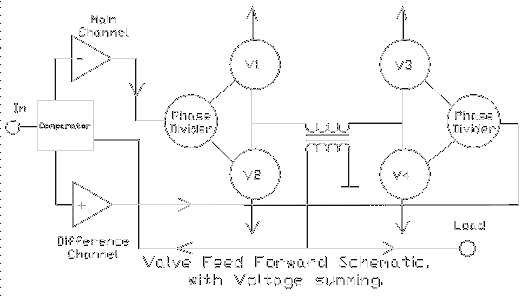 ©
© 
| |
|
|
|
|
|
|
|

Preface, a brief definition of amplifiers & amplification. A device for increasing the amount or amplitude of a parameter is frequently needed. Many work by increasing one value at the expense of another. A simple lever can increase mechanical force, but at the expense of travel, so there is no net gain. An electrical transformer can increase Voltage with a reduced current. Again no net increase in output power.
These are termed Passive devices.
An Amplifier is an Active device, a source of power is required apart from the input. Energy is drawn from this to provide the amplified output. A mechanical example is a brake servo, this uses power from a vehicle engine to increase force applied to brakes from a small pedal pressure.
There are many other mechanical examples, however this section is concerned only with the analogue electronic variety, for audio frequency use.
The general form consists of one or more Voltage amplifying stages followed by a power stage. Each stage uses a DC power source, with active devices to control current flow into an output load. The two main types of active device used are Thermionic Valves (vacuum tubes) and transistors.
Magnetic devices, such as saturable reactors, can be used in some applications. In general these have poor linearity for analogue audio & insufficient speed for digital. Their use will be covered in a separate section.
Magnetic technology should not, however, be dismissed. Advances in design may yet make the form viable. We are starting work on ideas for a stage amplifier. How this works out remains to be seen.
Digital amplification may use other devices, with switching capabilities, such as Thyristors or SCRs. This type can be highly efficient & handle high powers. From the early years of transistor amplification various designs have been tried, but use in audio has been limited. The genre will be discussed in a later section.
Some amps are falsely called digital. In reality they may have digital displays, effects, or be supposedly intended for digital sources. Our language is often abused in the name of commerce.
Non-linearity inherent in active devices distorts the signal being amplified. A long time ago it was realised that feeding back a proportion of the output signal to the input, in reversed phase, reduces that distortion. The Voltage gain is reduced by the same factor.
This is called Negative Feed Back (N.F.B.) & was pioneered commercially by Harold Leak of Leak amplifier fame. For the first time high quality audio reproduction became economically practicable.
Distortion. When an electrical signal is passed through any device the relationship between varying input levels & resultant output can be plotted on a graph. The result is often termed a transfer or characteristic curve. Ideally it should be a straight line (linear). The transfer function of an active device frequently departs from this ideal. The same is true of some passive components. Iron cored inductors, such as output transformers, exhibit 'non-linearity', especially when driven hard. Capacitors, other than air spaced types, show a dielectric 'memory' effect. This varies with materials used, polyester has a strong effect. The resultant linearity errors cause distortion at frequencies where reactance is significant in relation to associated components. The shape of a waveform is changed (distorted) by a non-linear characteristic. The result is measured in terms of the proportion of unwanted by-products created, expressed as a percentage or in decibels (dB). The dB is one tenth of a Bel, the common logarithm of a power ratio. The common British measure of distortion is the percentage that all added harmonics form of the final signal (Total Harmonic Distortion or T.H.D.). One method uses the purest possible sine wave at a set frequency as an input. Filtering the output, to remove just that frequency, leaves distortion products, plus circuit noise, hum etc. Measuring the output with no input gives the bachground noise figure. Subtracting this from the previous figure leaves just T.H.D. This is not very accurate, especially if noise is high compared to distortion. A more precise variant uses a narrow pass filter to measure each harmonic in turn. Since changing the shape of a sine wave results in the introduction of harmonics this is a reasonable measure of a circuit's linearity errors. An apparent anomaly is introduced, in musical instruments the presence of harmonics makes sound brighter & more interesting. So why are harmonics produced during amplification so objectionable? The short answer is that they are not. The full picture however is, as usual, more complex. Adding harmonics to an existing instrument can change its nature, making it less recognisable. There is a difference here between music production & reproduction. Players often make use of this effect, as when a solid bodied guitar's signal is deliberately distorted, adding timbral complexity. Another type of distortion artifact occurs when two or more differing frequencies are amplified together. The curved response can be seen as varying gain at different points on a waveform. Each of the frequencies present will modulate the amplitude of any others as they are swept through the curve. This results in the production of 'sum & difference' frequencies. The section on FM synthesis touches briefly on this subject. This is called 'Inter-modulation' (I.M.) distortion & is the real problem with non-linearity. Its products are often not harmonically related to original tones so the ear picks them out as unwanted sounds, or 'dirt'. It gets worse when more & complex signals are amplified. Harmonic distortion compounds I.M. since sum & difference signals occur between all the additional frequencies created. For this reason the American standard measure of quality is inter-modulation products (I.M.), again as a percentage of output signal. Two different sine wave frequencies are introduced, the measuring filter is set to the sum &/or difference. The two methods often produce vaguely similiar figures, depending on the type of non-linearity. An old arbitrary standard for high quality was less than a tenth of one percent harmonic content. A twentieth of one percent I.M. is probably a near equivalent. We expect at least a factor of ten better today. Loudspeakers often have around five percent harmonic distortion at high levels. I.M. can be minimised by separating high, middle & low frequency ranges into suitable drivers. The complexity & individuality of the human voice does not respond well to any kind of distortion. Amplification for speech or singing needs to provide the most faithful reproduction possible. The only addition sometimes desirable is reverberation, for adding life to an acoustically dull environment (or masking a dodgey singer).
Amplification, Negative Feedback An amplifier is proposed where very low levels of distortion & noise are primary design factors.
At first sight this seems straightforward enough, negative feedback reduces both, together with gain. For a simple sine wave the resultant distortion, below overload, is the original value divided by, one plus the product of original gain & the fraction of output signal fed back. Gain, noise & output impedance are reduced by the same ratio.
The feedback path, from output to input, completes a loop. The original gain, with feedback disconnected, is termed 'open loop' gain (OLA). The gain with the feedback path connected, is termed 'closed loop' gain (CLA). If OLA is very high in relation to CLA, the latter approximates to the reciprocal of the feedback fraction (FF). Distortion & noise are approximately divided by the product of OLA & FF.
A high open loop gain compared to closed loop gain appears to meet the design requirements. An additional benefit is predictability, gain, for example, is controlled, almost completely, by the ratio of feedback resistors. Negative feedback seems to be a designer's dream, a dramatic improvement in quality with no cost. Apart, that is, from an extra gain stage or two.
In reality however, there is more to it, nothing comes without a cost. Before moving on to factors affecting design, a simple comparison can be made.
On one hand an expensive 'high end' amplifier, on the other a cheap, unit construction 'Hi Fi' system. Both have very similiar specifications regarding noise, distortion & frequency response within the audio band. A tolerance of 3dB from 20 C/S to 20 KC/S is common for the latter, probably .5 dB for the expensive model. 2dB is just noticeable.
When tested, both models meet their specifications. Listening tests, however, paint a completely different picture. The expensive amplifier sounds pretty much as one would expect. No wild acrobatics of sound, just clear reproduction. The cheap unit sounds dull & boring. Treble is lifeless, something seems to be lacking.
Yet specifications are similiar, what can the ear hear that test equipment does not show? One essential parameter is left out of most specifications, 'phase linearity'. Equipment exists to measure this accurately, or a simple two channel oscilloscope setup can display phase errors reasonably well. |
Amplification, Negative Feedback
| 2: Design Factors | - | 1: Preliminary |
| |
|
|
|
|


